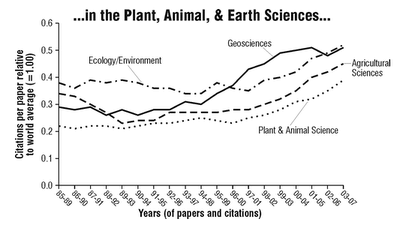Here are some stats:
In 1985, the number (number of papers indexed by Thomson Reuters) was approximately 12,500, and for the next 15 years the total never much exceeded 14,000. Around the year 2000, however, the number began to tick upwards, rising to nearly 17,000 in 2001, reaching 20,000-plus in 2003, and winding up at more than 27,000 in 2007.
and regarding citation stats...
Physics, as it happens, features prominently in the next set of graphs(2), which plot the nation's relative citation impact (that is, India's citations-per-paper average compared against the world average in each respective field) in 14 main fields in a series of overlapping periods from 1985 through 2007
. ...although the impact of India-based research lags the world average in the fields shown, the nation has been on a discernible upswing since roughly the year 2000, with notable gains in, for example, Geosciences(3), Neurosciences(4), and Biology & Biochemistry.
Geosciences citations have improved from being 30% of the world average to around 50% of the world average.
 Source: ScienceWatch
Source: ScienceWatchA slight improvement I guess over the last 20 years or so, but the condition of a lot of geoscience departments, especially those in state universities leaves a lot to be desired in terms of quality research output. I don't want to analyze this to death. Yes we are improving, but still far behind the U.S, Europe, Britain, Japan and China. A lot has been written on what ails Indian science. Here is a polemical view. And here is a more detailed and critical analysis.
I want to digress and write on a different matter.
I survey the research literature in sedimentary geology quite a bit and all along there has been only the rare publication by India based geologists in the leading geology journals on sedimentary topics. With one peculiar exception. Bengali geologists mostly based in eastern Indian Universities have been consistently publishing papers on sedimentary geology in internationally recognized journals.
I've often thought about this on and off and a number of reasons come to mind.
1) Proximity to sediments. Jadhavpur University Kolkata, Presidency College, Kolkata, Indian Statistical Institute, Kolkata, IIT Kharagpur and School of Mines, Dhanbad, where a lot of Bengali geologists are based are all within a days driving distance from a variety of sedimentary terrains. These include the Ganges-Brahmaputra fluvial- estuarine-delta complex, the Mio-Pliocene Himalayan foreland and the late Paleozoic-early Mesozoic Gondwana continental rift basins. But proximity cannot be the only reason. Plenty of other Indian universities to the west and south and north sit right on top of Proterozoic and Mesozoic basins.
2) Institutional support. The east is where the systematic study of geology began in India. Kolkata was the seat of British administration until the capital shifted to Delhi in the early 1900's. The Geological Survey of India was established in Kolkata in the late 1800's. There is a long tradition of geology in this part of the country reflected in well funded geology programs in various universities.
3) Economic incentives. There is coal in the eastern rift basins and oil was discovered early in the eastern state of Assam. There was a requirement for expertise in sedimentary geology and eastern universities developed strong sedimentary geology programs to provide it.
4) But Universities are only as good as the people who work in them. Geology frankly has never been a field which attracts the brightest students in India. Parental, social and economic pressures lead to Medicine, Engineering and Management being preferred. Among sciences, Math, Physics and Chemistry suck in the best students. But there has been strong social and cultural support in Bengal for pursuing any kind of an intellectual career. So maybe many more bright Bengali students become geology researchers than elsewhere in India.
I remember my first ever meeting with my graduate adviser in the U.S. "Meet me at 8.00 am sharp", he barked on the phone. And so I went to his office, braving a bitterly cold mid-west January morning. He was a Bengali sedimentary geologist and a fine one too. Winner of the SEPM paper of the year award for 1986 for his excellent work on alluvial sandstones from the late Paleozoic-early Mesozoic rift basins of eastern India.
Maybe there is a germ of truth to my thesis :-)

No comments:
Post a Comment